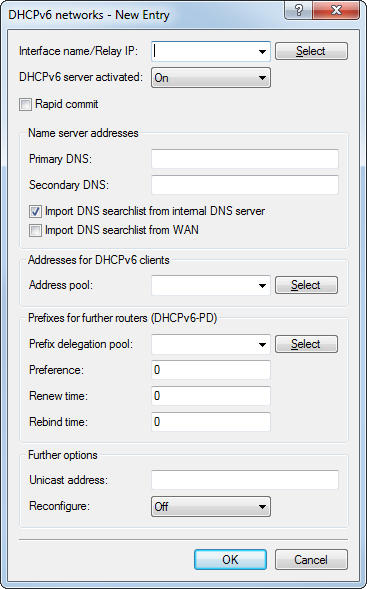This table is used to configure the basic settings of the DHCPv6 server, and to specify which interfaces they apply to.

- Interface name/Relay IP
- Name of the interface on which the DHCPv6 server is working, for example "INTRANET". Alternatively, you can also enter the IPv6 address of the remote DHCPv6 relay agent.
- DHCPv6 server activated
- Activates or deactivates the entry.
- Rapid commit
- With rapid commit activated, the DHCPv6 server responds directly to a solicit message with a reply message.Note: The client must explicitly include the rapid commit option in its solicit message.
- Primary DNS
- IPv6 address of the primary DNS server. The value "::" means that the DHCPv6 server announces its own address as a DNS server to the clients.
- Secondary DNS
- IPv6 address of the secondary DNS server.
- Import DNS search list from internal DNS server
- Indicates whether the DNS search list or the own domain for this logical network should be inserted from the internal DNS server, e.g., "internal". The own domain is configured under . The default setting is "enabled".
- Import DNS search list from WAN
- Specifies whether the DNS search list sent by the provider (e.g., provider-xy.de) is announced in this logical network. The default setting is "disabled".
- Address pool
- Name of the address pool used for this interface.Note: If the DHCPv6 server operates stateful addresses distribution, you must enter the corresponding addresses into the Address pools table.
- Prefix delegation pool
- Name of prefix pools to be used by the DHCPv6 server.Note: If the DHCPv6 server is to delegate prefixes to other routers, you must enter the corresponding prefixes in the table Prefix delegation pools.
- Preference
- Where multiple DHCPv6 servers are operated on the network, the preference parameter gives you the control over which server the clients will use. The primary server requires a higher preference value than the backup server.
- Renew time
- This specifies the time in seconds when the client should contact the server again (using a renew message) to extend the address/prefix received from the server. The parameter is also called T1.
- Rebind time
- This specifies the time when the client should contact any server (using a rebind message) to extend its delegated address/prefix. The rebind event occurs only if the client receives no answer its renew request. The parameter is also called T2. With the default of 0, this happens automatically.
- Unicast address
- By default the DHCPv6 server exclusively responds to multicast requests. If the DHCPv6 server should respond to a unicast request, this IPv6 address can be configured here. Generally speaking, multicast is sufficient for communication.
- Reconfigure
-
Each IPv6 address or IPv6 prefix has a default life time assigned by the server. At certain intervals, a client asks the server to renew its address (called renew/rebind times).
The reconfigure feature allows the DHCPv6 server to require the clients in the network to request a renewal of leases / bindings. If the client successfully negotiates a re-configuration (reconfigure) with the server during first contact, the server can request the client to update its address or other information at any time. The mechanism is protected by the so-called Reconfigure Key, so that only the original server with the correct key can make requests to the client. If the client receives a reconfigure message without a valid reconfigure key, the client rejects this invocation.
The Reconfigure Key Authentication Protocol according to RFC 3315 is supported for Renew and Information-Request, as well as Rebind according to RFC 6644. Reconfiguration is started on the CLI of the device using a "do" command in the status tree:
do /Status/IPv6/DHCPv6/Server/Reconfigure
The command expects the following parameters:- renew: (optional, default) Asks the client to perform a renewal for his address and/or prefix.
- rebind: (optional) Asks the client to perform a rebind for his address and/or prefix.
- info: (optional) Asks the client to send an Information-Request, in order to, for example, update its DNS server.
- -c <Client-ID>: The reconfigure function applies to the client with the specified client ID.
- -b <Address/Prefix>: The reconfigure function applies to the client with the specified address and the specified prefix.
- -i <Interface/Relay>: The reconfigure function applies to all clients that are connected to the specified interface or relay.
- -a: The reconfigure function applies to all clients.
Note: You can find more about the status of a client regarding the Reconfigure function under .In LANconfig the following settings are available for reconfiguration:- Off
- Disables the reconfigure function
- Reject
- Clients that have used the Reconfigure Option in queries are rejected by the server and are not assigned an address, prefix or other options.
- Allow
- If the client sets the Reconfigure Option in queries, the server negotiates the necessary parameters with the client in order to start a reconfiguration at a later time.
- Require
- Clients have to set the Reconfigure Option in queries, otherwise the client rejects these clients. This mode is makes sense when you want to ensure that the server only serves clients which support Reconfigure. This ensure that all clients can use Reconfigure to update their addresses, prefixes, or other information at a later point in time.
